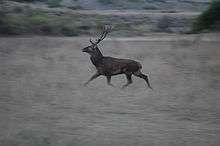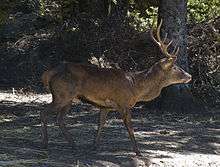Corsican red deer
The Corsican red deer (Cervus elaphus corsicanus or Cervus corsicanus), also known simply as the Corsican deer or Sardinian deer, is a subspecies of the red deer (Cervus elaphus), endemic to the Mediterranean islands of Sardinia (Italy) and Corsica (France).
| Cervus elaphus corsicanus | |
|---|---|
 | |
| A male Corsican red deer | |
| Scientific classification | |
| Kingdom: | Animalia |
| Phylum: | Chordata |
| Class: | Mammalia |
| Order: | Artiodactyla |
| Family: | Cervidae |
| Subfamily: | Cervinae |
| Genus: | Cervus |
| Species: | |
| Subspecies: | C. e. corsicanus |
| Trinomial name | |
| Cervus elaphus corsicanus Erxleben, 1777 | |
Characteristics

The Corsican red deer is smaller than most of the 16 subspecies of the red deer; it has shorter legs (possibly to better scramble up mountain sides) and a longer tail.[2] The antlers are also simplified and shorter, typically less than 80 cm (31 in) in length. The coat is brownish. Life expectancy is 13–14 years. Males reach a height of 86 to 110 cm (34 to 43 in) and a weight of 100 to 110 kg (220 to 240 lb); while females measure 80 to 90 cm (31 to 35 in) and weight 80 kg (180 lb).[3]
Reproduction
This subspecies reach sexual maturity at 2 years of age. Mating lasts from August to November and can involve mortal battles. The dominant male finally secures most of the mature females, typically 12 per male. After gestation, in May–July, females hide alone in the maquis (the dense vegetation) to deliver, typically a single birth per female. Males leave the matriarchal group following the reproductive period.[3]
Distribution and habitat
The Corsican red deer is native to the Tyrrhenian islands of Corsica and Sardinia. Today, it lives in the wild in sanctuaries on both islands; for example, it is bred in the Monte Arcosu Forest in Sardinia and in the Parc Naturel Régional de Corse, which covers almost 40% of the island, where it was reintroduced from Sardinia after its extinction in the 1970s.[2]
Conservation status
The subspecies gets its name from the island of Corsica from where it was, however, extirpated in the early 1970s. At that time, the less than 250 animals that still existed on Sardinia were protected and plans were elaborated for a reintroduction on Corsica. Captive breeding on the latter island began in 1985 and the population increased from 13 founders to 186 captive animals. Reintroduction could finally begin in 1998, and as of 2007, the Corsican population was about 250 individuals, with a total of about 1,000 for the subspecies, which has therefore been downgraded to near threatened on the IUCN Red List.[4]
See also
Notes
- https://ecos.fws.gov/ecp0/profile/speciesProfile?sId=4089
- Hughes West 2008, p 146
- Natura 2000, in French
- Kidjo et al. 2007
References
- Hughes, Holly; West, Larry (2008). "Regional Nature Park of Corsica: Welcome Home, Deer". Frommer's 500 Places to See Before They Disappear. Frommer's. ISBN 0-470-18986-X.
- Kidjo, Nicolas; Feracci, Gérard; Bideau, Eric; Gonzalez, Georges; Mattéi, César; Marchand, Bernard; Aulagnier, Stéphane (2007). "Extirpation and reintroduction of the Corsican red deer Cervus elaphus corsicanus in Corsica". Oryx. Cambridge University Press (41): 488–494. doi:10.1017/S0030605307012069.
| Wikimedia Commons has media related to Cervus elaphus corsicanus. |

